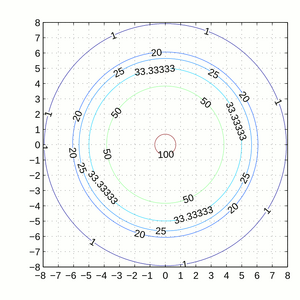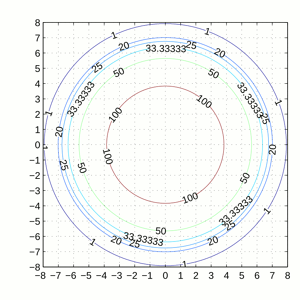Dinamita explotando.
Una explosión es un suceso físico y, por lo general, destructivo, que puede ocurrir por varias circunstancias. Puede destruir bloques cercanos, causar daños a los jugadores cercanos, entidades y armaduras y, a veces, producir fuego. Las explosiones reproducen el efecto de partículas "shockwave".
Multiple close explosions may propel objects further, but have no cumulative effect on the destruction of a bloque. This is because explosions' damage to blocks is evaluated individually (por explosión), and blocks' blast resistance does not become "weakened" per explosion.
"Destroyed" blocks have a chance of dropping as collectible resources (and otherwise disappear), and this chance is one divided by the explosion power. So, a creeper blast (uncharged) will have a 1/3 chance of dropping a block.
The propulsion effect of explosions is often used for TNT cannons.
| Tipo de explosión | Potencia | Notas |
|---|---|---|
| Plantilla:EntityLink (al aparecer) | 7 | |
| Plantilla:EntityLink | 6 | Puede hacer fuego |
| Plantilla:EntityLink | 6 | |
| Cama (en el Inframundo o el Fin) | 5 | Hace fuego |
| Dinamita | 4 | |
| Plantilla:EntityLink | 3 | |
| Bola de Plantilla:EntityLink | 1 | Hace fuego |
| Plantilla:EntityLink | 1 | |
| Plantilla:EntityLink | 1 | Treats blast radius blocks (except bedrock and end portal frames) as having a blast resistance of no more than 4. |
Efecto
Modelo de destrucción del bloque
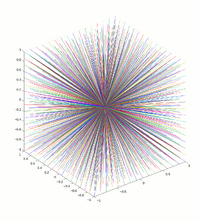
1352 rays from the explosion center to points that uniformly distributed on the surface of a cube centered at the explosion with an edge length of 2. (However, this only defines their directions, not their length)
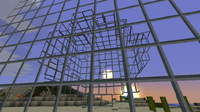
The roughly spherical pattern of blocks destroyed can be seen here.
An explosion can destroy nearby blocks. Its blast effect is evaluated independently on many explosion rays originating from the explosion center, as shown in the right figure.
- Each ray has an initial blast force randomized in [0.7 × power, 1.3 × power].
- The effect of the blast force is examined at checkpoints on the ray with step length of 0.3.
- The blast force is absorbed (block resistance/5 + 0.3) × step length by the non-air block (no matter whether destroyed) at each checkpoint, and attenuated by step length × 0.75 between checkpoints, until completely absorbed or attenuated.
- A block is considered destroyed if it can't completely absorb the blast force at any checkpoint in it (air blocks can be destroyed too).
From the above process, the following results can be deduced (where ⌊x⌋ is the floor function):
- The blast radius in the air of an explosion (i.e. only attenuated, not absorbed by blocks) = ⌊1.3 × power/(step length × 0.75)⌋ × step length = 10.2 (charged creepers), 6.9 (TNT), 5.1 (creepers), 1.5 (fireballs). For example, a TNT explosion can destroy a torch 7 blocks away. But how many blocks an explosion can destroy is non-deterministic and also dependent on the specific location of the explosion.
- The minimum block resistance required to absorb maximum blast force of an explosion happening in nearby air = ((1.3 × power − attenuation steps × step length × 0.75)/step length − 0.3) × 5. To not be destroyed, a block has to absorb all blast force at the first checkpoint in it.
- The attenuation steps is subject to collision restrictions. For explosion in air, there is at least one attenuation step. TNT and creeper explosion are always 0.49 and 0.5 meter away from nearest block (2 att. steps), but fireball explosion can happen anywhere (1 att. step).
- Thus, the block resistances are 121.00 (charged creepers), 77.67 (TNT), 56.00 (creepers), 16.42 (fireballs).
- So water, lava (Note: Only the stationary block) obsidian, and bedrock are always indestructible, and fences and less blast-resistant blocks can be destroyed by fireballs. These are theoretical values, and in reality less resistant blocks are not always destroyed, and since Minecraft is supposed to be simple, there is no such mechanic.
Interaction with entities
An explosion has different effects on entities than blocks. Entities are damaged and propelled by an explosion if within its damage radius of 2 × power. Note that the "damage radius" is different from the blast radius of explosion effect on blocks.
- For each entity within the radius, define impact = (1 − distance from the explosion/radius) × exposure.
- Apply (impact2 + impact) × 8 × power + 1 point (half-heart, so we don't have to divide by 2 everywhere) of damage to the entity.
- Propel the entity so that its velocity increases by impact in the direction from explosion to the entity.
From the above process, the following results can be deduced:
- Entities will always get at least 1 point of damage if they are within the radius, regardless of their explosion exposure.
- The maximum damage that entities can take (at the explosion center with 100% exposure) = (1 × 1 + 1) × 8 × power + 1 point of damage = 97 (charged creeper), 65 (TNT), 49 (creepers), 17 (fireballs). When entities are away or covered by blocks from the explosion center, they take less damage.
- The maximum velocity gain that an entity can obtain from a TNT explosion is 1, at the explosion center with 100% exposure.
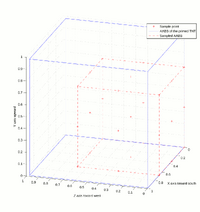
A primed TNT AABB has directionally asymmetrical sample points (1/2.96 spacing) because of rounding.
Calculation of explosion exposure
Explosion exposure is simply how much an entity is visible from the explosion center, and is approximated with the ratio of visible sample points on the entity. The approximation algorithm has sampling error that results in directional asymmetry of propulsion. For example, a typical TNT Cannon has maximum range in the west direction partly because the primed TNT has largest sampled exposure in that direction.
Causing fire
If the explosion has the ability, it randomly starts fires in ⅓ of all destroyed air blocks that are above opaque blocks.
Permanent lag
Permanent lag is essentially lag-fallout from an explosion, this consists of drops, liquid-physics, and increased render-complexity of the crater. Technically the drops will disappear after 5 minutes, however that's 5 in-game minutes which may take a long time to process during extreme lag.
It is recommended that when making a large creative-mode explosion, one uses the command "/gamerule doTileDrops false" to stop drops from being generated by explosions. If you are using 1.8 or higher the code "/kill @e[type=Item]" will destroy all drops, however in 1.7 or earlier the same code will just kill the player.
Resistencia a explosiones
| Block name | Blast resistance |
|---|---|
| Bedrock | |
| Command Block | |
| End Portal | |
| End Portal (block) | |
| Anvil | |
| Enchantment table | |
| Obsidian | |
| Ender Chest | |
| Flowing Water |
500 |
| Lava |
500 |
| Water |
500 |
| Dragon Egg | |
| End Stone | |
| Block of Diamond |
30 |
| Block of Emerald |
30 |
| Block of Gold |
30 |
| Block of Iron |
30 |
| Block of Redstone |
30 |
| Bricks | |
| Brick Stairs |
30 |
| Hardened Clay |
30 |
| Cobblestone | |
| Cobblestone Stairs |
30 |
| Cobblestone Wall |
30 |
| Iron Bars |
30 |
| Jukebox |
30 |
| Moss Stone | |
| Nether Brick | |
| Nether Brick Fence | |
| Nether Brick Stairs |
30 |
| Stone | |
| Stone Brick | |
| Stone Brick Stairs |
30 |
| Stone Slabs | |
| Iron Door |
25 |
| Monster Spawner |
25 |
| Cobweb |
20 |
| Dispenser |
17,5 |
| Dropper |
17,5 |
| Furnace |
17,5 |
| Beacon |
15 |
| Coal Ore |
15 |
| Cocoa |
15 |
| Diamond Ore |
15 |
| Emerald Ore |
15 |
| Fence |
15 |
| Fence Gate |
15 |
| Gold Ore |
15 |
| Hopper |
15 |
| Block name | Blast resistance |
|---|---|
| Iron Ore |
15 |
| Lapis Lazuli Block |
15 |
| Lapis Lazuli Ore |
15 |
| Nether Quartz Ore | |
| Redstone Ore |
15 |
| Trapdoor |
15 |
| Wood Planks |
15 |
| Wooden Door |
15 |
| Wood Slabs |
15 |
| Wood Stairs |
15 |
| Chest |
12,5 |
| Crafting tabla | |
| Trapped Chest |
12,5 |
| Cauldron |
10 |
| Wood |
10 |
| Bookshelf |
7,5 |
| Jack 'o' Lantern |
5 |
| Melon |
5 |
| Mob head |
5 |
| Pumpkin |
5 |
| Sign |
5 |
| Block of Quartz |
4 |
| Quartz Stairs |
4 |
| Note Block |
4 |
| Sandstone |
4 |
| Sandstone Stairs |
4 |
| Wool |
4 |
| Monster Egg |
3,75 |
| Activator Rail |
3,5 |
| Detector Rail |
3,5 |
| Powered Rail |
3,5 |
| Rail |
3,5 |
| Clay (block) |
3 |
| Farmland |
3 |
| Grass Block |
3 |
| Gravel |
3 |
| Sponge |
3 |
| Brewing Stand |
2,5 |
| Button |
2,5 |
| Cake |
2,5 |
| Dirt |
2,5 |
| Hay Bale |
2,5 |
| Ice |
2,5 |
| Lever |
2,5 |
| Mycelium |
2,5 |
| Piston |
2,5 |
| Piston Extension |
2,5 |
| Pressure Plate |
2,5 |
| Sand |
2,5 |
| Block name | Blast resistance |
|---|---|
| Soul Sand |
2,5 |
| Sticky Piston |
2,5 |
| Weighted Pressure Plate |
2,5 |
| Cactus |
2 |
| Ladder |
2 |
| Netherrack |
2 |
| Glass |
1,5 |
| Glass Pane |
1,5 |
| Glowstone |
1,5 |
| Redstone Lamp |
1,5 |
| Stained Glass |
1,5 |
| Stained Glass Pane |
1,5 |
| Bed |
1 |
| Daylight Sensor |
1 |
| Huge Mushrooms |
1 |
| Leaves |
1 |
| Snow |
1 |
| Vines |
1 |
| Carpet |
0,5 |
| Snow (cover) |
0,5 |
| Air |
0 |
| Carrot |
0 |
| Dead Bush |
0 |
| Fire |
0 |
| Flower Pot |
0 |
| Flowers |
0 |
| Flowing Lava |
0 |
| Grass |
0 |
| Lily Pad |
0 |
| Locked Chest |
0 |
| Melon Stem |
0 |
| Mushrooms |
0 |
| Nether Portal |
0 |
| Nether Wart |
0 |
| Piston Moving |
0 |
| Potato |
0 |
| Pumpkin Stem |
0 |
| Redstone Comparator |
0 |
| Redstone Repeater |
0 |
| Redstone Torch |
0 |
| Redstone Wire |
0 |
| Saplings |
0 |
| Wheat |
0 |
| Sugar Cane |
0 |
| TNT |
0 |
| Torch |
0 |
| Tripwire |
0 |
| Tripwire Hook |
0 |
Typical damage radius
The player will receive damage, if within these radii of a 100% exposure ground 1-, 2-, or 4-TNT explosion, with the amount of damage labeled on each circle in the figures below.
Historial
Plantilla:History Plantilla:History Plantilla:History Plantilla:History Plantilla:History Plantilla:History Plantilla:History Plantilla:History Plantilla:History Plantilla:History Plantilla:History Plantilla:History Plantilla:History Plantilla:History Plantilla:History Plantilla:History Plantilla:History Plantilla:History Plantilla:History Plantilla:History Plantilla:History
Curiosidad
- Explosions more powerful than 100 look mostly the same from the outside, as only certain lines are used to determine if a block breaks. However, some of those lines continue underground.
- An explosion powerful enough to break bedrock would have a blast radius of over 30,000,000 blocks. If it were an uninterrupted blast, it would cover 238,775,501.2 blocks. However, explosions only follow certain lines, not every block (see previous).
- Any explosion going off in flowing water will apply propulsion to entities, but it will not affect any block, whether the blast resistance of that block is low or high.
- Explosions in or under water won't emit particles.
- Explosions can redirect projectiles including Ender Pearls.
- Explosions can break blocks on the other side of blast-resistant blocks that survive.
- Explosions will propel dead mobs' bodies if they go off just after the mobs dies.
- If primed TNT explodes in a large, solid cube of stone blocks, it will create an exact 3x3x3 cube inside.
- Experimentation confirms that a TNT detonation will cause a 3x3 hole in a solid block of anything with a blast resistance less than that of water, but more than 12.5 (e.g. crafting tables). This implies that 3x3 is the minimum possible result of a TNT detonation without the blast being resisted altogether.
- If a Falling Sand entity falls into Primed TNT when in water, it will do block damage.
- In Minecraft Pocket Edition, if you break 2 blocks in the center of a 3x3 square, and place TNT in the middle, it will almost always make a 3x3x3 hole, granted that no dirt, gravel, or bedrock is around.
Referencias
Plantilla:Reflist
| Guías | |||||||||||||||||
|---|---|---|---|---|---|---|---|---|---|---|---|---|---|---|---|---|---|
| Menús |
| ||||||||||||||||
| Desarrolladores | |||||||||||||||||
| Personalización | |||||||||||||||||
| Ediciones |
| ||||||||||||||||
| Juegos |
| ||||||||||||||||
| Películas |
| ||||||||||||||||
| Libros |
| ||||||||||||||||
| Otros medios |
| ||||||||||||||||
| Eventos |
| ||||||||||||||||
| Merchandising oficial | |||||||||||||||||
| Misceláneo | |||||||||||||||||


